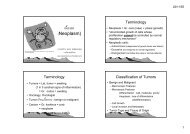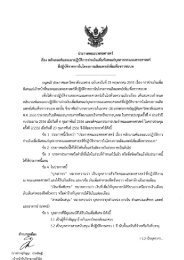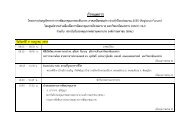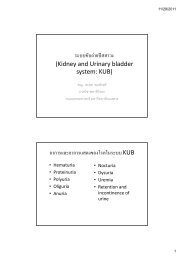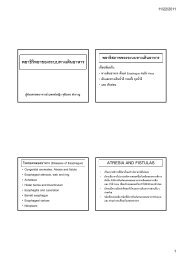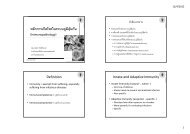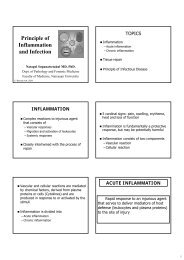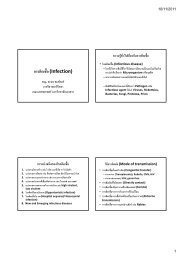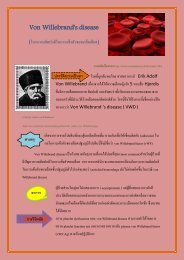Nutritional Pathology Topics Nutritional ... - มหาวิทยาลัยนเรศวร
Nutritional Pathology Topics Nutritional ... - มหาวิทยาลัยนเรศวร
Nutritional Pathology Topics Nutritional ... - มหาวิทยาลัยนเรศวร
You also want an ePaper? Increase the reach of your titles
YUMPU automatically turns print PDFs into web optimized ePapers that Google loves.
9/7/2012ภาวะทุพโภชนาการ (Malnutrition)Primary malnutrition : missing from the dietSecondary malnutrition : adequate nutrientssupply, but malnutrition may result from- Malabsorption- Impaired nutrient use or storage- Excess nutrient losses- Increased need for nutrients(GI diseases, chronic wasting diseases,acute critical illness)Common Causes• Poverty (homeless, aged, children)• Ignorance(infants, adolescents, pregnant women)• Chronic alcoholism• Acute and chronic illnesses(trauma, burn, cancer, etc.)• Self-imposed dietary restrictionProtein - Energy malnutrition (PEM)- PEM refers to a range of clinicalsyndrome characterized by aninadequate dietary intake of proteinand calories to meet the body’s needs.- Primary (children) and Secondary(illness) PEM- Two polar forms: - Marasmus,- Kwashiorkor A B2
9/7/20121. Marasmus.- Severe reduction in caloric intake- Greater than 60% reduction in body weight- Most common during the first year of life- Use somatic protein component &subcutaneous fat as a source of energy- Serum albumin levels are either normal or onlyslightly reduced- Growth retardation, multivitamin deficiencies,anemia, immune deficiencyMarasmus2. Kwashiorkor- More severe form of malnutrition than marasmus- Mainly occur in children 6 months to 3 years of age- Occurs when protein deprivation is relatively greaterthan the reduction in total calories- Loss of visceral protein component- Hypoalbuminemia → generalized edema- Fatty change of liver- Skin lesion : hypo-and hyperpigmentation,desquamation- Hair change : overall loss of color or alternating band(flag sign), straightening, loss of firm attachment tothe scalp- Multivitamin deficiencies, anemia, immune deficiency3
9/7/2012Secondary PEM.SyndromeClinicalsettingTimecourseClinical featuresLaboratoryfindingsPrognosis1. marasmuslikePEMChronicillness (e.g.,chronic lungdisease,cancer)MonthsHistory of weightloss, musclewasting, absentsubcutaneous fat“Cachexia”Normal ormildlyreducedserumproteinsVariable;dependsonunderlyingdiseaseKwashiorkor2. kwashiorkorlikePEMAcute,catabolicillness (e.g.,severetrauma,burn, sepsis)WeeksNormal fat andmuscle , edema,easily pluckablehairSerumalbumin 2.8 gm/dlpoor<strong>Topics</strong>• <strong>Nutritional</strong> deficiencies– Protein – Energy Malnutrition– Anorexia Nervosa and Bulimia– Vitamin Deficiencies– Mineral Deficiencies• Obesity• Diet and Systemic DiseasesAnorexia Nervosa• Self-induced starvation, resulting in markedweight loss• Manifested as severe PEM with endocrineabnormalities– Amenorrhea (GnRH, LH, FSH)– Decreased bone density (low estrogen level)– Decreased thyroid hormone release (coldintolerance, bradycardia, constipation)• Increased susceptibility to cardiacarrhythmia and sudden death4
9/7/2012http://www.funatiq.com/images/anorexia-nervosa-model.jpgAnorexia Nervosahttp://www.womenshealthzone.net/eating-disorders/anorexia-nervosa/effects/img/1287.gifhttp://1.bp.blogspot.com/_cBDzDLF1zns/SE_ELpvdbjI/AAAAAAAAACk/92KsZWfMR8M/S740/normal_00031778.jpgBulimia• A condition in which the patient binges onfood and then induces vomiting• Amenorrhea occurs in less than 50% of Pt.,Wt. and gonadotropin levels are near normal• Major medical complications:– Electrolyte imbalances (Hypokalemia) and cardiacarrhythmia– Pulmonary aspiration of gastric content– Esophageal and cardiac rupturehttp://www.netscool.com/elrio/daniela/bulimia.jpg5
9/7/2012<strong>Topics</strong>Bulimia• <strong>Nutritional</strong> deficiencies– Protein – Energy Malnutrition– Anorexia Nervosa and Bulimia– Vitamin Deficiencies– Mineral Deficiencies• Obesity• Diet and Systemic Diseaseshttp://internationalteenlife.pbworks.com/f/bulimia.gifhttp://www.topnews.in/files/Bulimia.jpghttp://purgingpoet.today.com/files/2009/04/effects_of_bulimia.jpghttp://4.bp.blogspot.com/_zRiLerjhL2c/Rh8dELoSWOI/AAAAAAAAAVM/BoGHNraqwwQ/s400/bulimia.bmpVitamin Deficienciesand Toxicities• Fat soluble vitamins– A, D, E, K– Deficiency due to abnormal fatabsorption– Accumulate and toxicity• Water soluble vitamins– B1, B2, B3, B6, B12, C, Folate• Ascorbic acid• Niacin• Pyridoxine• Cobalamin• Retinoic acid• Thiamine• Riboflavin• Tocopherol• CalciferolCB3B6B12AB1B2ED• Other names, Source6
9/7/2012Vitamin A Deficiency: night blindness: Bitot’s spot (small plaques of keratin debris),keratomalacia (corneal ulcer and destruction),xerophthalmia (dry eye), total blindness: Squamous metaplasia 2 o pulmonary infection,KUB stone (keratin debris): vulnerability to infection (measle, pneumonia,diarrhea)Bitot’s spotXerophthalmia with corneal ulcerCorneal scaringCorneal ulcer towards keratomalaciahttp://www.cehjournal.org/images/ts040006.jpgVitamin D1, 25 (OH)2 D is the active form of vitamin D(synthesis from kidney by 1-hydroxylase)Function: stimulate intestinal absorption of Ca and P.: collaborates with PTH in the mobilization ofCa from bone.: stimulate the PTH-dependent reabsorptionof Ca in the distal renal tubules7
9/7/2012RicketsVitamin DDeficiency : Rickets (children): Osteomalacia (adult): Hypocalcemia tetany- an excess of unmineralized matrix (osteoid)- Intramembranous bone formation(direct ossification of embryonic connectivetissue ; membrane bone of skull)- Endochondral bone formation(Intracartilaginous replacement of hyalinecartilage; bone of trunk and extremitiescartilage)8
9/7/2012During nonambulatory stage of infancy:- Head : ศีรษะแบน เปนสี่เหลี่ยม หนาผากนูน (craniotabes,frontal bossing, squared appearance)- Chest : rachitic rosary at costochondraljunction, pigeon breast deformity,Harrison’s groove.Rachitic rosaryDuring ambulatory stage of infancy :Pelvis deformity, lumbar lordosis,bowing legs.9
9/7/2012Pectus excavatum (Funnel chest)Pectus carinatum (Pigeon chest)http://www.patient.co.uk/doctor/Chest-Deformity.htmhttp://www.respir.com/images/SemeioPectusExt.jpghttp://www.nlm.nih.gov/medlineplus/ency/images/ency/fullsize/9583.jpgOsteomalacia- Vitamin D deficiency in adult- Contour of the bone are notaffected- Bone is weak and vulnerable tofracture due to osteopeniaBowing legs10
9/7/2012Vitamin E (a-tocopheral)- serves as a scavenger of free radicals, theantioxidant effect- may reduce mutagenesis- Cause of deficiency : deficient diet is uncommon: occurs in association withmalabsorption syndromes, infants of low birthweight, developmental defects in the GI tract, orlipoprotein disorders.Vitamin E Deficiency: Poor nerve conduction,axon degenerationon the posterior columns of the spinalcord, loss of nerve cells in the dorsalroot ganglia, and degenerative changes inthe spinocerebellar tracts: The neurologic manifestations areataxia, dysarthria, absent tendonreflexes, and loss of position sense andpain sensation.Vitamin K- Clotting factor 2, 7, 9, 10- Anticoagulant protein C and S- May favor calcification of boneproteins and inhibit bone resorption prevent osteoporosisVitamin K Deficiency: ภาวะเลือดออกงาย (bleeding diathesis): Intracranial hemorrhage of thenewborn11
9/7/2012Cause of deficiency :–fat malabsorption syndromes(biliary tract disease)–destruction of the endogenousvitamin–synthesizing flora (ingestion ofbroad-spectrum antibiotics)–neonatal period–Diffuse liver disease–Drug (e.g., warfarin)Vitamin B1 (thiamine)Function : maintains neural membranes andnormal nerve conduction, especially peripheralnerveDeficiency : most common in chronic alcoholism,result in syndromes of- dry beriberi (polyneuropathy)- wet beriberi (heart failure, peripheral edema)- Wernicke – Korsakoff Syndrome(irriversible)Wernicke – Korsakoff Syndrome• Lesions in the CNS : hemorrhage anddegeneration of mammillarv bodies,periventicular region of thalamus, floor of forthventricle, anterior region of cerebellum• Wernicke encephalopathy is marked byophthalmoplegia, nystagmus, ataxia of gait andconfusion• Korsakoff psychosis consists of impairment ofremote, recall, confabulation, and inability toacquire new information12
9/7/2012Vitamin B2 (Riboflovin)- cheilosis (cheilitis, angular stomatitis):first + most characteristic sign (crack +fissure at the angles)- Glossitis : tongue atrophy, red-bluediscoloration- Eye change : interstitial keratitis, cornealvascularization, corneal ulcer- Scaling dermatitis : nasolabial folds and cheek(butterfly distribution), scrotal, vulva13
9/7/2012Vitamin B3 (Niacin)- an essential component of NAD + and NADP- Pellagra (3 D’s):- Dermatitis sharply demarcated scaling anddesquamation of exposure area, bilaterallysymmetry- Diarrhea caused by atrophy of thegastrointestinal epithelium- Dementia results from neuron degenerationin the brain, and in the spinal cordVitamin B6 (Pyridoxine)Deficiency state- Most common in chronic alcoholismand pregnancy- Clinical findings resemble vit. B2 +niacin deficiencies (seborrheic dermatitis,cheilosis, glossitis, peripheral neuropathy,convulsion)Vitamin B12 (Cobalamin)- Coenzyme in the DNA synthetic pathway(as well as folic acid)- Vit.B12 + R-binder(saliva) protease (pancreas)vit.B12 + intrinsic factor(gastric parietal cell)absorb at ileum14
9/7/2012Folate- Coenzyme in the DNA synthetic pathway- Absorb at proximal jejunum- Deficiency : clinically some as vitamin B12deficiency except neurologic change: Neural tube defects in thedeveloping fetus (first few weeks postconception)AnencephalySpina bifidahttp://www.asylumeclectica.com/asylum/malady/archives/anenceph/anen6.jpghttp://compcolts.wikispaces.com/file/view/spina_bifida.jpghttp://www.scienceclarified.com/images/uesc_02_img0090.jpg15
9/7/2012Vitamin C (Ascorbic acid)-Function : hydroxylation ofprocollagen, antioxidant-Deficiency : impaired synthesisof collagen (bone and vessel)scurvyPerifollicular hemorrhage16
9/7/2012<strong>Topics</strong>• <strong>Nutritional</strong> deficiencies– Protein – Energy Malnutrition– Anorexia Nervosa and Bulimia– Vitamin Deficiencies– Mineral Deficiencies• Obesity• Diet and Systemic DiseasesMineral Deficienciesand Toxicities• Iron– Iron deficiency : Iron deficiency anemia– Iron excess : Hemochromatosis• Iodine : deficiency : Multinodular goiter• Zinc : deficiency : Acrodermatitisenteropathica• Copper : excess : Wilson’s diseaseIron Deficiency: dietary lack, increased requirement, chronicblood loss: koilonychia (spoon nail), alopecia: atrophic changes in the tongue and gastricmucosa, intestinal malabsorption: hypochromic microcytic anemia, poikilocytosis# Plummer – Vinson syndrome:1.) microcytic hypochromic anemia2.) Atrophic glossitis3.) Esophageal webs (dysphagia)Hypochromic microcytic anemia with poikilocytosis17
9/7/2012Koilonychiahttp://www.topnews.in/files/iodine-deficiency.jpgZinc- Acrodermatitis enteropathica, AR ( oftenaround eye, nose, mouth, anus and distal parts)- Anorexia with diarrhea- Growth retardation in children- Impaired wound healing- Hypogonadism- Altered immune function- Impaired night vision- Depressed mental function- Increased incidence of congenital malformationsin infants of zinc-deficient mother18
9/7/2012Mineral toxicities• Hemochromatosis (Fe) : Liver, pancreas• Cirrhosis, DM, cardiac dysfunction• Thalassemia (Fe)• Kayser-Fleischer Ring (Cu)• Hepatolenticular degeneration, brainlesion, Wilson’s disease (Cu)Acrodermatitis enteropathicahttp://www.mayomedicallaboratories.com/articles/hottopics/transcripts/2009/2009-1a-hemochromatosis/1a-16.htmlhttp://www.eurowilson.com/rc/org/eurowilson/htm/Article/2009/htm-20090520-075732-571/src/htm_fullText/en/graph_symptomes_ENG.gif19
9/7/2012<strong>Topics</strong>??• <strong>Nutritional</strong> deficiencies– Protein – Energy Malnutrition– Anorexia Nervosa and Bulimia– Vitamin Deficiencies– Mineral Deficiencies• Obesity• Diet and Systemic DiseasesObesityObesityMesurement : Body mass index (BMI) = Wt (kg)/Ht(m) 2: Body–fat percentage (skin foldmeasurement) and lean body weightBMI : normal = 18.5 – 24.9 kg./m 2: overweight = 25.0 – 29.9 kg./m 2: obesity 30.0 kg./m 2http://www.impactlab.com/wp-content/uploads/2008/09/obese3.jpg20
9/7/2012Neurohumoral mechanism• เปนกลไกการควบคุมการเผาผลาญพลังงาน• Afferent (humoral) signals : leptin(adiposetissue), insulin, ghrelin(stomach)• Hypothalamus (central melanocortin system)• Efferent : feeding behavior + energyexpenditure (TRH and autonomic pathway)Food–derived energy > energy expenditureStorage as triglycerides in adipose tissue (insulin effect)- Daily requirement : 2000 – 3000 kcal/d.- Daily energy expenditure = Basal energy expenditure (BEE)+Activities.BEE man = 66 + (13.7 x Wt.) + (5 x Ht.) – (6.8 x age)BEE woman = 655 + (9.5 x Wt.) + (1.8 x Ht.) – (4.7 x age)Wt (Kg), Ht (cm.), Age (yrs)Factors contributing toobesity :1. Genetic predisposition2. Decreased lipid utitization : aging,defective thermogenesis, inactivity,underexcercising3. Sociocultural environment : stress,emotional, disturbances4. Diseases : hypothalamic disorder.: hypothyroidism.: Cushing’s syndrome.: Polycystic ovary syndrome.21
9/7/2012Exercise more than 3 times per week1. Aerobic exercise = moderate intensity+ long duration (20 – 45 min.) use oxegen to burn fat Cardiovascular protection2. Anaerobic exercise = high intensity +short duration. glycogenolysis + muscular hypertrophy<strong>Topics</strong>• <strong>Nutritional</strong> deficiencies– Protein – Energy Malnutrition– Anorexia Nervosa and Bulimia– Vitamin Deficiencies– Mineral Deficiencies• Obesity• Diet and Systemic DiseasesDiet and systemic diseases• Fiber cholesterol level diverticulosis, CA colon• Fish oil omega–3 FA cholesterol andcoronary heart disease• Restricted Na intake HT• Restricted protein diet in liver disease andchronic renal failure22
9/7/2012ขอมูลเพิ่มเติม• สํานักงานกองทุนสนับสนุนการสรางเสริมสุขภาพhttp://www.thaihealth.or.th/about• โครงการคนไทยไรพุง กรมอนามัย กระทรวงสาธารณสุขhttp://nutrition.anamai.moph.go.th/web/khonthairaipung.html• สํานักโภชนาการ กรมอนามัย กระทรวงสาธารณสุขhttp://nutrition.anamai.moph.go.th/References• สุภรณ พงศะบุตร, บรรณาธิการ, “ตําราพยาธิวิทยาทั่วไป.”, ภาควิชาพยาธิวิทยาและนิติเวชศาสตร, โกลบอลพริ้นท, 2551, หนา 417-438.• Kumar V., Abbas A. K., Fausto N.,“Robbins and Cotran Pathologic Basisof Disease, 7th edition.”, ElsevierSaunders, 2005, p.446-466.23



